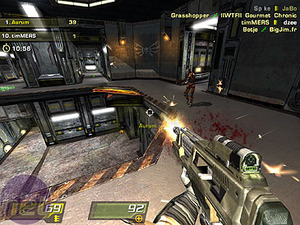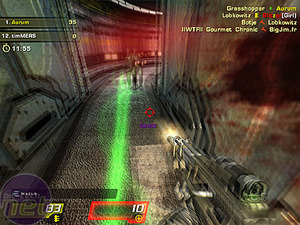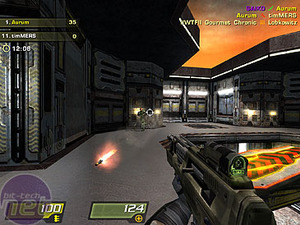
Quake 4
The game that has inspired me to sit down and write this piece, I am totally enamoured with Q4. It's a great example of what I call the 'arcade shooter'.Heritage
Quake 4 has a long legacy. Its most direct ancestors are Doom 3 and Quake 3. The former provides the cutting edge graphics engine that powers the game. Doom 3 made its debut late 2004, and whilst the graphics blew everyone away, the gameplay - and, in particular, the multiplayer - was generally felt to be lacking.
The problems with Doom 3 were weapon balance and level design, as well as the general feel of the game. The multiplayer was unlike Quake, lacking the pace, scale and the clever level design. Great multiplayer level design takes dedication, and the design in Doom 3 rather felt like a bunch of people in a singleplayer level. The weapons were uninspiring, and lacked any real connection back to the much-loved weapons from the original Doom.


The glorious familiarity
Part of the glory of Q4 is the familiarity of the weapons and the items and the levels. Where Doom 3 was a departure from the look and feel of both Doom and Quake, Q4 has an instant familiarity to gamers like me who remember numbers 2 and 3. The weapons are balanced exquisitely, although some of them are perhaps a little lacking. The rocket launcher appears a little underpowered, and it certainly doesn't look as hard-hitting in game. The nail gun had potential to be a great return from the original Quake, but its startup time renders it next to useless. However, the return of identical grenade launchers and railguns are a huge bonus.
Arcade shooter
Quake 3 is the direct predecessor of Quake 4, obviously, and the multiplayer in the latter is an updated and tweaked version. Why is it an arcade shooter, and what does that term mean? Well, the gameplay is fast paced, and it's not realistic, both of which I'd say are characteristics. Quake 4 is all about speed, both physically and mentally. Insanely quick reactions are needed, much like the old arcade games of yore, and the ability to assess a situation and quickly work out a way to play it to your advantage is also key.
I would argue that another characteristic of an arcade shooter is that the use of tactics is very different from something like an out-and-out tactical shooter. Playing CS or Ghost Recon, tactics become a matter of team organisation, intimate map knowledge and pre-planning of a battle plan. Those concepts play a small roll in arcade shooters, but tactics here revolve more around weapon strategy, as well as domination of key items and areas. With CS, your weapons are a given - there is no tactical advantage to be had from dominating an item on the map. In Quake, the player who spends the most time with the rocket launcher on a small, enclosed map will have a big advantage. Likewise, the ability to consistently nail the Railgun on The Longest Yard (combined with hours of pixel-perfecting practice) will yield the tactical advantage.
Physics abuses are key in shooters - exploiting the effects and rules written into the engine to gain another advantage. This abuse led to the invention of rocket and grenade jumping, which has become so commonplace that the return of the technique was one of the highlighted features of multiplayer Quake 4. Similar physics abuses in tactical games, such as bunnyhopping in CS, have been locked down.
Related to this is the issue of more subtle physics abuses, such as the ability to jump-and-gun. The strafing-jumping-spinning-headshot was a common technique in pre-1.0 CS days, but its use has been steadily locked down in an effort to add to realism. In Q4, the technique is almost compulsory, and the ability to zoom and rail an opponent whilst both of you are flying through the air in different directions is the hallmark of a pro.
Tournament play
Some would suggest that Quake 4 has the potential to be the most exciting competitive game yet. It has fast action, and a constant respawn means that players are not out of the game for long. The graphics are astounding (amking for a visually appealing game to watch), and the quick reactions and thinking needed make it more akin to a 'real' sport than perhaps any other game.
Quake 2 was the first real tournament game, with Q2DM1 being perhaps the most played deathmatch map of all time. Whilst professional gamers have flirted with Doom 3, the major tournaments this year have been played, for the most part, on Painkiller - a far more fast paced game. However, with that game looking long in the tooth, it rather appears that Quake 4 is going to get some serious competitive frag-time.


The future
Where's the future? Well, if the publishers have any sense, more maps, more tweaking and more exposure. One of the things that has kept CS at the forefront of gamer's thoughts has been the constant refreshing and updating of the game through its post-beta stages. Quake 4 has the potential to be an enormously popular multiplayer title if a community can be created around it, part of which will stem from the longevity provided by updates. CS always has something 'new', and this has given the huge CS community something to focus on consistently. We'd really like to see Quake have the same attention, and see a return to the days where all the top gamers are playing on Quake.

MSI MPG Velox 100R Chassis Review
October 14 2021 | 15:04









Want to comment? Please log in.